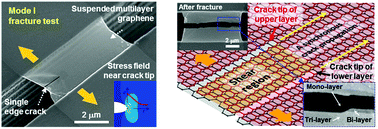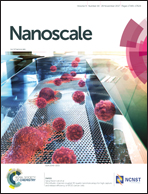Asynchronous cracking with dissimilar paths in multilayer graphene†
Abstract
Multilayer graphene consists of a stack of single-atomic-thick monolayer graphene sheets bound with π–π interactions and is a fascinating model material opening up a new field of fracture mechanics. In this study, fracture behavior of single-crystalline multilayer graphene was investigated using an in situ mode I fracture test under a scanning electron microscope, and abnormal crack propagation in multilayer graphene was identified for the first time. The fracture toughness of graphene was determined from the measured load–displacement curves and the realistic finite element modelling of specimen geometries. Nonlinear fracture behavior of the multilayer graphene is discussed based on nonlinear elastic fracture mechanics. In situ scanning electron microscope images obtained during the fracture test showed asynchronous crack propagation along independent paths, causing interlayer shear stress and slippages. We also found that energy dissipation by interlayer slippages between the graphene layers is the reason for the enhanced fracture toughness of multilayer graphene. The asynchronous cracking with independent paths is a unique cracking and toughening mechanism for single-crystalline multilayer graphene, which is not observed for the monolayer graphene. This could provide a useful insight for the design and development of graphene-based composite materials for structural applications.



 Please wait while we load your content...
Please wait while we load your content...